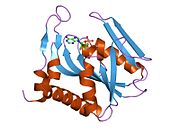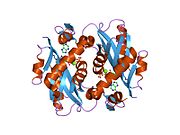Adenine phosphoribosyltransferase: Difference between revisions
Tags: Mobile edit Mobile app edit |
→Further reading: 10.1007/978-1-4615-2584-4_137 |
||
| Line 23: | Line 23: | ||
==Further reading== |
==Further reading== |
||
{{refbegin | 2}} |
{{refbegin | 2}} |
||
*{{cite journal | author=Tischfield JA, Engle SJ, Gupta PK |title=Germline and somatic mutation at the APRT locus of mice and man. |journal=Adv. Exp. Med. Biol. |volume=370 |issue= |pages= 661–4 |year= 1995 |pmid= 7660991 |doi= |display-authors=etal}} |
*{{cite journal | author=Tischfield JA, Engle SJ, Gupta PK |title=Germline and somatic mutation at the APRT locus of mice and man. |journal=Adv. Exp. Med. Biol. |volume=370 |issue= |pages= 661–4 |year= 1995 |pmid= 7660991 |doi= 10.1007/978-1-4615-2584-4_137 |display-authors=etal}} |
||
*{{cite journal | author=Takeuchi H, Kaneko Y, Fujita J, Yoshida O |title=A case of a compound heterozygote for adenine phosphoribosyltransferase deficiency (APRT*J/APRT*Q0) leading to 2,8-dihydroxyadenine urolithiasis: review of the reported cases with 2,8-dihydroxyadenine stones in Japan. |journal=J. Urol. |volume=149 |issue= 4 |pages= 824–6 |year= 1993 |pmid= 8455250 |doi= }} |
*{{cite journal | author=Takeuchi H, Kaneko Y, Fujita J, Yoshida O |title=A case of a compound heterozygote for adenine phosphoribosyltransferase deficiency (APRT*J/APRT*Q0) leading to 2,8-dihydroxyadenine urolithiasis: review of the reported cases with 2,8-dihydroxyadenine stones in Japan. |journal=J. Urol. |volume=149 |issue= 4 |pages= 824–6 |year= 1993 |pmid= 8455250 |doi= }} |
||
*{{cite journal | author=Ludwig H, Kuzmits R, Pietschmann H, Müller MM |title=Enzymes of the purine interconversion system in chronic lymphatic leukemia: decreased purine nucleoside phosphorylase and adenosine deaminase activity. |journal=Blut |volume=39 |issue= 5 |pages= 309–15 |year= 1980 |pmid= 116697 |doi=10.1007/BF01014193 }} |
*{{cite journal | author=Ludwig H, Kuzmits R, Pietschmann H, Müller MM |title=Enzymes of the purine interconversion system in chronic lymphatic leukemia: decreased purine nucleoside phosphorylase and adenosine deaminase activity. |journal=Blut |volume=39 |issue= 5 |pages= 309–15 |year= 1980 |pmid= 116697 |doi=10.1007/BF01014193 }} |
||
Revision as of 09:36, 23 August 2015
Template:PBB Adenine phosphoribosyltransferase is an enzyme that in humans is encoded by the APRT gene.[1]
Function
APRTase is an enzyme involved in the purine nucleotide salvage pathway. It functions as a catalyst in the reaction between adenine and phosphoribosyl pyrophosphate (PRPP) to form AMP.
APRT is functionally related to hypoxanthine-guanine phosphoribosyltransferase (HPRT).
Pathology
Deficiency purines APRT in human beings may lead to kidney stones formed of adenine and salts.
2,8-Dihydroxy-adenine urolithiasis is also known as "adenine phosphoribosyltransferase deficiency".
Adenine phosphoribosyltransferase (APRT) deficiency is an uncommon genetic disorder that often causes kidney stones, and in some patients kidney failure. More than 300 individuals with this disease have been reported world-wide but it is not known how common this medical problem truly is. Patients with the disease deficiency lack the enzyme adenine phosphoribosyltransferase and therefore have difficulties breaking down purines. This may result in the accumulation 2,8-dihydroxyadenine (2,8-DHA) that is excreted by the kidneys. 2,8-DHA is poorly soluble in the urine leads to the formation of kidney stones and kidney injury.[1]
Interestingly, up to 70% of affected patients, have red hair or relatives with this hair color.
References
Further reading
- Tischfield JA, Engle SJ, Gupta PK; et al. (1995). "Germline and somatic mutation at the APRT locus of mice and man". Adv. Exp. Med. Biol. 370: 661–4. doi:10.1007/978-1-4615-2584-4_137. PMID 7660991.
{{cite journal}}: CS1 maint: multiple names: authors list (link) - Takeuchi H, Kaneko Y, Fujita J, Yoshida O (1993). "A case of a compound heterozygote for adenine phosphoribosyltransferase deficiency (APRT*J/APRT*Q0) leading to 2,8-dihydroxyadenine urolithiasis: review of the reported cases with 2,8-dihydroxyadenine stones in Japan". J. Urol. 149 (4): 824–6. PMID 8455250.
{{cite journal}}: CS1 maint: multiple names: authors list (link) - Ludwig H, Kuzmits R, Pietschmann H, Müller MM (1980). "Enzymes of the purine interconversion system in chronic lymphatic leukemia: decreased purine nucleoside phosphorylase and adenosine deaminase activity". Blut. 39 (5): 309–15. doi:10.1007/BF01014193. PMID 116697.
{{cite journal}}: CS1 maint: multiple names: authors list (link) - Johnson LA, Gordon RB, Emmerson BT (1977). "Adenine phosphoribosyltransferase: a simple spectrophotometric assay and the incidence of mutation in the normal population". Biochem. Genet. 15 (3–4): 265–72. doi:10.1007/BF00484458. PMID 869896.
{{cite journal}}: CS1 maint: multiple names: authors list (link) - Kamatani N, Hakoda M, Otsuka S; et al. (1992). "Only three mutations account for almost all defective alleles causing adenine phosphoribosyltransferase deficiency in Japanese patients". J. Clin. Invest. 90 (1): 130–5. doi:10.1172/JCI115825. PMC 443071. PMID 1353080.
{{cite journal}}: CS1 maint: multiple names: authors list (link) - Chen J, Sahota A, Laxdal T; et al. (1992). "Identification of a single missense mutation in the adenine phosphoribosyltransferase (APRT) gene from five Icelandic patients and a British patient". Am. J. Hum. Genet. 49 (6): 1306–11. PMC 1686459. PMID 1746557.
{{cite journal}}: CS1 maint: multiple names: authors list (link) - Mimori A, Hidaka Y, Wu VC; et al. (1991). "A mutant allele common to the type I adenine phosphoribosyltransferase deficiency in Japanese subjects". Am. J. Hum. Genet. 48 (1): 103–7. PMC 1682758. PMID 1985452.
{{cite journal}}: CS1 maint: multiple names: authors list (link) - Chen J, Sahota A, Stambrook PJ, Tischfield JA (1991). "Polymerase chain reaction amplification and sequence analysis of human mutant adenine phosphoribosyltransferase genes: the nature and frequency of errors caused by Taq DNA polymerase". Mutat. Res. 249 (1): 169–76. doi:10.1016/0027-5107(91)90143-C. PMID 2067530.
{{cite journal}}: CS1 maint: multiple names: authors list (link) - Gathof BS, Sahota A, Gresser U; et al. (1992). "Identification of a splice mutation at the adenine phosphoribosyltransferase locus in a German family". Klin. Wochenschr. 69 (24): 1152–5. doi:10.1007/BF01815434. PMID 2135300.
{{cite journal}}: CS1 maint: multiple names: authors list (link) - Kamatani N, Kuroshima S, Hakoda M; et al. (1990). "Crossovers within a short DNA sequence indicate a long evolutionary history of the APRT*J mutation". Hum. Genet. 85 (6): 600–4. doi:10.1007/BF00193582. PMID 2227951.
{{cite journal}}: CS1 maint: multiple names: authors list (link) - Kamatani N, Kuroshima S, Terai C; et al. (1989). "Detection of an amino acid substitution in the mutant enzyme for a special type of adenine phosphoribosyltransferase (APRT) deficiency by sequence-specific protein cleavage". Am. J. Hum. Genet. 45 (2): 325–31. PMC 1683345. PMID 2502918.
{{cite journal}}: CS1 maint: multiple names: authors list (link) - Hidaka Y, Tarlé SA, Fujimori S; et al. (1988). "Human adenine phosphoribosyltransferase deficiency. Demonstration of a single mutant allele common to the Japanese". J. Clin. Invest. 81 (3): 945–50. doi:10.1172/JCI113408. PMC 442550. PMID 3343350.
{{cite journal}}: CS1 maint: multiple names: authors list (link) - Wilson JM, O'Toole TE, Argos P; et al. (1986). "Human adenine phosphoribosyltransferase. Complete amino acid sequence of the erythrocyte enzyme". J. Biol. Chem. 261 (29): 13677–83. PMID 3531209.
{{cite journal}}: CS1 maint: multiple names: authors list (link) - Broderick TP, Schaff DA, Bertino AM; et al. (1987). "Comparative anatomy of the human APRT gene and enzyme: nucleotide sequence divergence and conservation of a nonrandom CpG dinucleotide arrangement". Proc. Natl. Acad. Sci. U.S.A. 84 (10): 3349–53. doi:10.1073/pnas.84.10.3349. PMC 304867. PMID 3554238.
{{cite journal}}: CS1 maint: multiple names: authors list (link) - Hidaka Y, Palella TD, O'Toole TE; et al. (1987). "Human adenine phosphoribosyltransferase. Identification of allelic mutations at the nucleotide level as a cause of complete deficiency of the enzyme". J. Clin. Invest. 80 (5): 1409–15. doi:10.1172/JCI113219. PMC 442397. PMID 3680503.
{{cite journal}}: CS1 maint: multiple names: authors list (link) - Hidaka Y, Tarlé SA, O'Toole TE; et al. (1988). "Nucleotide sequence of the human APRT gene". Nucleic Acids Res. 15 (21): 9086. doi:10.1093/nar/15.21.9086. PMC 306432. PMID 3684585.
{{cite journal}}: CS1 maint: multiple names: authors list (link) - Chen J, Sahota A, Martin GF; et al. (1993). "Analysis of germline and in vivo somatic mutations in the human adenine phosphoribosyltransferase gene: mutational hot spots at the intron 4 splice donor site and at codon 87". Mutat. Res. 287 (2): 217–25. doi:10.1016/0027-5107(93)90014-7. PMID 7685481.
{{cite journal}}: CS1 maint: multiple names: authors list (link) - Sahota A, Chen J, Boyadjiev SA; et al. (1994). "Missense mutation in the adenine phosphoribosyltransferase gene causing 2,8-dihydroxyadenine urolithiasis". Hum. Mol. Genet. 3 (5): 817–8. doi:10.1093/hmg/3.5.817. PMID 7915931.
{{cite journal}}: CS1 maint: multiple names: authors list (link)
External links
- Adenine+phosphoribosyltransferase at the U.S. National Library of Medicine Medical Subject Headings (MeSH)




